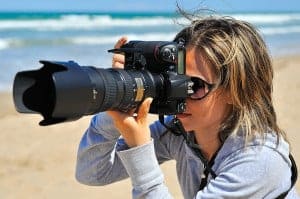
Like DSLR video or not, it is all the buzz in the photography industry today. In fact, I'm writing a new eBook on DSLR video. No matter how you feel about it personally, I thought it would be useful for beginning videographers to understand what all the buzz is about.
Personal home video cameras have existed for many years. Remember the 90’s when we all went to our kids’ soccer games with that huge video camera over our shoulders that recorded to a cassette? Because consumer-level video is not a new development, many people wonder why so many people have suddenly become interested in DSLR video since 2009. The answer is that, for the first time, consumer level video cameras are able to record professional movie-quality videos. This change occurred because of the introduction of video capabilities in DSLRs.
DSLR cameras have at least three distinct advantages over what was possible on the personal handy-cams that we have all owned for years. Your first instinct may be to say that DSLR cameras are capable of recording in HD. While this does increase the clarity of the video, my smartphone is also capable of recording in HD and it certainly does not look like professional video.
The first, and perhaps most important, DSLRs have a large enough imaging sensor (the little computer chip that replaces the film) that the camera is able to capture short depth of field. Depth-of-field simply means making the subject of a shot sharp, and the background out of focus. The larger the imaging sensor, the shallower the depth-of-field can become. Traditional video recorders use tiny sensors which are not capable of achieving short depth-of-field. Utilizing short depth-of-field to make the background of a shot out of focus is perhaps the best and easiest way to instantly make your video look professional.
The second main advantage enjoyed by DSLR video shooters is the ability to shoot at varying frame rates. When you mortgage the house and donate plasma for a month so you can afford the insanely high costs of going to see a movie in the theater, you see video shot at 24 frames per second. That means that the camera took 24 still pictures in the space of a second, and then the frames are shown in rapid succession to make it appear as if a fluid and smooth movement is being shown.
Traditional consumer-level video cameras record at a faster rate than movies, so the resulting image has a different “look” to it. There are actually valid reasons why video camera manufacturers chose to use a higher frame rate (such as reducing blur), but the result was the inability of budding videographers to capture a cinematic look to their video. Fortunately, DSLRs have the ability to shoot at 24fps, so that “movie look” is easy to produce.
The last principal advantage to shooting DSLR video is the camera’s ability to record more information on the memory card without unnecessary dumping of information. This advantage is somewhat more hidden than the first two advantages, but it becomes apparent when you understand post-processing of video. When a camera takes a frame for video, it has to decide what information is most important and then the camera deletes all information which is not absolutely necessary to produce the image. The loss of this information limits the ability of videographers to make stylistic changes in color, levels, and contrast in post-production. DSLR videographers can control this important setting by using different picture styles (Canon) or picture controls (Nikon) to record video.
The combination of these three factors means that the DSLR camera is, in many significant respects, on par with or superior to traditional professional movie cameras which often cost in excess of $50,000. For this reason, in the last few years, several movies and primetime television shows have been videoed using nothing but HDSLR cameras rather than traditional movie cameras. Simply owning a DSLR and a few other basic accessories puts you on a level almost equal to many film makers with seemingly unlimited budgets. The only thing keeping you from producing professional quality video is your lack of knowledge.
What do you think about DSLR video? Leave a comment below and let me know your thoughts.

What I haven’t seen in the past on handheld camcorders was the apparent effect of high speed panning showing up as a kind of waterfall diagonal split on my DSLR. Is that common to both or just the DLSR?
Interesting that this site would use someone holding a DSLR in a “portrait” orientation and label it “DSLR video”. That’s not the usual orientation for video, to say the least.
Ha! Good point. You caught me.
I am just starting to use the video capture feature on my D7000 and I need lots of advice on camera settings and what ever equipment is necessary to get clips that are not jerky. Also, I need help with editing. BB
you mentioned you were writing an e-book, is it finished yet?
In regards to the solar panel and lithgs where did you get the items needed for 250 dollars? And does it have all the instructions? Or do you have to know how to do the rest? Any help would be great Thank You so much